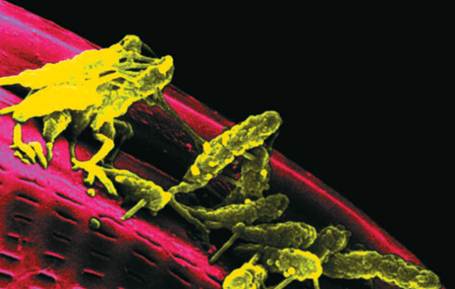


 النبات
النبات
 الحيوان
الحيوان
 الأحياء المجهرية
الأحياء المجهرية
 علم الأمراض
علم الأمراض
 التقانة الإحيائية
التقانة الإحيائية
 التقنية الحيوية المكروبية
التقنية الحيوية المكروبية
 التقنية الحياتية النانوية
التقنية الحياتية النانوية
 علم الأجنة
علم الأجنة
 الأحياء الجزيئي
الأحياء الجزيئي
 علم وظائف الأعضاء
علم وظائف الأعضاء
 الغدد
الغدد
 المضادات الحيوية
المضادات الحيوية|
Read More
Date: 22-10-2015
Date: 14-10-2015
Date: 22-10-2015
|
History of Taxonomy
Taxonomy, the field of biological classification, attempts to group types of organisms in meaningful ways. Modern taxonomy is based on similarities among organisms that reflect descent from recent shared ancestors, rather than similar solutions to environmental challenges. For example, a bird’s wing and a human’s arm reflect common descent from a vertebrate ancestor, whereas a bird’s wing and an insect’s wing are derived from different structures and therefore not characteristics on which modern classification might be based.
Taxonomic designations increasingly rely on deoxyribonucleic acid (DNA) sequence similarities. Because DNA mutates at a known rate, the more alike the DNA sequences are for two types of organisms, the more recently they diverged from a shared ancestor. By considering such data on pairs of species, biologists can construct evolutionary tree diagrams that depict how existing organisms are related to one another. In this way, taxonomy in the modern sense reflects evolution.

Carolus Linnaeus, the great eighteenth-century taxonomist, distinguished plants by their sexual parts.
Early Classification Schemes
Humans have probably always classified life. Thousands of years ago, people designated plants, animals, and fungi by whether they were tasty and safe to eat, of medicinal value, or were foul-tasting or even poisonous. An early taxonomist was Greek philosopher Aristotle (384-322 B.C.), who organized five hundred types of animals according to habitat and body form. His designations were rather subjective: he considered animals that gave birth to live young and had lungs as the pinnacle of living perfection.
By the sixteenth century, explorers had discovered so many new species that Aristotle’s plan could no longer suffice. Newer schemes continued to be based on what people could see, but the characteristics considered were often more mystical than scientific. For example, an early-sixteenth-century botanical classification assigns a high ranking to the plantain, because “more than any other plant, it bears witness to God’s omnipotence.” John Ray (1627-1705) was an English naturalist who classified more than twenty thousand types of plants and animals. His highly descriptive method distinguished animals by their hoofs, nails, claws, teeth, and toes. Yet the inability to see microscopic distinctions and reliance on superficial similarities led him to group together algae, lichens, fungi, and corals. A lichen is a compound organism that consists of an alga and a fungus, but a coral is an animal.
Carolus Linnaeus (1707-1778) is the best-known taxonomist. Heavily influenced by John Ray, Linnaeus compared, contrasted, and meticulously listed types of organisms from his earliest childhood. He started his first botanical listing at age eight, which evolved into a series of publications called Systema Naturare, reaching twenty-five hundred pages by its tenth edition. Linnaeus distinguished plants by their sexual parts. He is most noted for introducing the binomial name for a species, which includes an organism’s genus and “specific epithet,” an adjective that describes the species in some way. The human animal, according to Linnaeus’s scheme, is Homo sapiens, sapiens meaning “wise.” French anatomist Georges Cuvier (1769-1832) and others contributed broader levels of taxonomic classification: family, order, class, phylum or division, and kingdom. The full taxonomic classification of humans is: Animalia (kingdom), Chordata (phylum), Mammalia (class), Primates (order), Hominidae (family), Homo (genus), sapiens (specific epithet).
Beyond Plants and Animals
As biologists catalogued more of life’s diversity, classification as plant or animal was no longer sufficient. For a while, biologists assigned to the plant kingdom anything that couldn’t move, such as the fungi. These organisms are not plants because they do not photosynthesize, among other distinctions. Then the invention of the microscope revealed an entirely hidden, but vastly populated, world. In 1866, German naturalist Ernst Haeckel(1834-1919) proposed a third kingdom, Protista, to include one-celled organisms. But Protista according to this early definition lumped together some very different types of organisms. In 1937, French marine biologist Edouard Chatton made an enormous contribution to biology by introducing the terms prokaryote and eukaryote. The prokaryotes lack nuclei; eukaryotes have nuclei as well as other organelles, and include unicellular and multicellular life. The prokaryotes include bacteria, cyanobacteria, and the fairly recently recognized archaea.

The discovery of archaea in the 1970s led scientists to add a taxonomic level, called domain, above kingdom.
By 1959, it became clear that three kingdoms weren’t enough. For a decade, several four-kingdom schemes reigned. One approach split singlecelled life into prokaryotes and eukaryotes; another separated fungi from plants. Both changes were included in Cornell University ecologist Robert Whittaker’s five-kingdom system. He introduced it in 1969 and it prevailed for many years. Whittaker’s scheme recognized the Monera (prokaryotes), Protista (unicellular eukaryotes), Fungi, Plantae, and Animalia.
Enter the Archaea
Classification of life reflects the tools that scientists have to observe organisms and to compare their characteristics. With the ability to distinguish nucleic acid sequences in the 1970s came a new way to deduce evolutionary relationships and classify organisms on this basis. Carl Woese, a microbiologist at the University of Illinois, analyzed the ribosomal ribonucleic acid (rRNA) genes of various microbes, reasoning that these genes are so vital that they would be similar in sequence among different types of organisms. (That is, any major deviation would be lethal.) Comparing the differences in sequence, therefore, might be useful in establishing evolutionary relationships. He quickly learned that prokaryotes and eukaryotes have very distinctive rRNA gene sequences.
After examining the rRNA genes of all of the microbes in his colleagues’ labs, Woese turned to an organism in a more natural habitat, Methanobacter thermoautotrophica, a methane-emitting microbe found in a nearby lake. Its rRNA genes were markedly different in sequence from the prokaryotic“signature.” Woese found others like it. This new class of microbes also had different lipid molecules in their membranes than other bacteria. Eventually, when the list had grown, Woese published his work. In 1977 he introduced the archaebacteria and suggested that a new and broader taxonomic level, called the domain, embrace them.
Early use of the term “archaebacteria” led to much initial confusion, because these organisms are quite different from bacteria, although they are also small and lack nuclei. Because the first archaea that Woese worked with were found in what are termed extreme environments—high heat, salt, or pressure—the idea arose that this was one of their key characteristics. Since then, however, biologists have found archaea in many habitats, including rice paddies, swamps, and throughout the oceans. To identify them, biologists just had to know what to look for.
The three domains of life are the Archaea, the Prokarya, and the Eu- karya. Both the Archaea and the Prokarya consist of unicellular organisms that are prokaryotic cells. The Eukarya includes the eukaryotes (protista, plants, fungi, and animals). This invention of domains to supercede kingdoms solved a problem that the identification of archaea brought to Whittaker’s five-kingdom scheme. At first, the archaea were considered a sixth kingdom. The dilemma was that the differences between archaea and any of the other five kingdoms were greater than the differences among those other kingdoms. The three-domain organization has gained acceptance as distinctions among the groups have accumulated. Today scientists know that archaea lack nuclei and organelles like the bacteria, their cell walls are distinctive, and their mechanisms of DNA replication and protein synthesis are more like those of eukaryotes than other prokaryotes. The genome sequences of a few archaea have confirmed what Woese proposed a quarter century ago: that they share some characteristics with bacteria and eukaryotes, but are very much a distinct type of organism. On a more philosophical note, the addition of domains to biological classification indicates that taxonomy is very much a dynamic discipline.
References
Mayr, Ernst. “Two Empires or Three?” Proceedings of the National Academy of Science 95 (1998): 9720-9723.
Wade, Nicholas. “Rethinking the Universal Ancestor: A New ‘Tree of Life.’” New York Times (June 4, 2000): F1.
Woese, Carl R., and George E. Fox. “Phylogenetic Structure of the Prokaryotic Domain: The Primary Kingdoms.” Proceedings of the National Academy of Science 74 (1977): 5088-5090.



|
|
|
|
لشعر لامع وكثيف وصحي.. وصفة تكشف "سرا آسيويا" قديما
|
|
|
|
|
|
|
كيفية الحفاظ على فرامل السيارة لضمان الأمان المثالي
|
|
|
|
|
|
|
العتبة العباسية المقدسة تجري القرعة الخاصة بأداء مناسك الحج لمنتسبيها
|
|
|